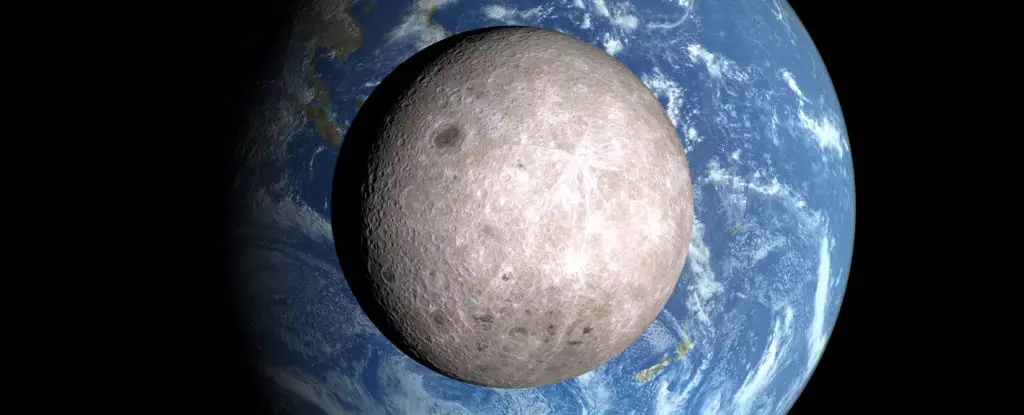The Moon, our enigmatic celestial neighbor, presents a striking dichotomy between its near and far sides that has long perplexed scientists. Recent studies have illuminated this lunar mystery, revealing a curious imbalance in water distribution across its surface. Historically, the lunar near side—the hemisphere facing Earth—has been more volcanic and smooth, characterized by vast basaltic plains known as maria. In contrast, the far side, hidden from our direct view, features a rugged landscape marked by an abundance of craters. This uneven distribution provides a detailed canvas for understanding not just the Moon’s geological history but also the formative events that shaped our Solar System.
The significance of this lopsided nature takes center stage with the exploration of water abundance, particularly in the lunar mantle. Research conducted by a team from the Chinese Academy of Sciences, led by planetary physicists Huicun He and Linxi Li, suggests that the far side of the Moon is drier than its near counterpart. Scanning electron microscopy and electron probe microanalysis of samples collected by China’s Chang’e-6 mission has shed new light on the hydration levels of various minerals, indicating startlingly low water content—around 1 to 1.5 micrograms per gram of rock in the basalt from the South Pole-Aitken Basin.
The Impact of Water on Lunar Formation Theories
Understanding the water distribution on the Moon is not merely an academic exercise; it has profound implications for our models of lunar formation. The prevailing theory suggests that the Moon formed through a cataclysmic collision between a Mars-sized body named Theia and the early Earth over 4.5 billion years ago. This impact theory provides a framework for interpreting the Moon’s geological attributes. The resultant debris coalesced into a body that initially was characterized by a molten surface, heavily influenced by the dynamics of planetary formation.
He and Li’s research highlights that the abundance—or scarcity—of water within the lunar mantle can yield insights into the broader processes of planetary evolution. According to their findings, the hydration levels of the Moon’s interior could dictate the patterns of volcanism visible on the surface and key processes of magma crystallization. Surprisingly, the stark water scarcity on the far side may reflect the asymmetrical cooling rates as the Moon transitioned from a molten state. Such fundamental differences raise essential questions about the conditions present after the Moon’s formation. Did the near side retain more heat and thus witness increased volcanic activity due to its alignment with Earth? Or is there a more intricate interplay of factors, perhaps unknown, affecting these variations?
The Geological Implications of the Chang’e-6 Findings
The Chang’e-6 mission has dramatically advanced our understanding of the Moon’s geology by bringing back the first samples from its far side. The implications of these samples are vast. Previous studies concentrated predominantly on the near side, particularly the Procellarum KREEP Terrane—a mineral-rich area with abundant potassium, phosphorus, and rare-earth elements. With the new samples from the far side, scientists have a unique opportunity to compare chemical compositions and understand why the far side has fewer basaltic features.
It’s also worth considering the physical impacts that formed these regions. The South Pole-Aitken Basin is a prime candidate for study due to its colossal scale and the geological processes thought to have taken place there. The hypothesis suggests that an impact event of this magnitude could have shifted substantial material toward the near side of the Moon, effectively redistributing its geological features and mineral content. As scientists continue to investigate, the existing questions multiply: What else lies beneath the surface? Might more water exist in various sectors of the far side, awaiting discovery?
Lunar Exploration: A Glimpse into the Future
The revelations from the Chang’e-6 mission not only confirm our theories surrounding the Moon’s dichotomy, but they also ignite a greater passion for lunar exploration. The need for more samples and greater geological insights is pressing. Whether through automated missions or human expeditions, our quest for lunar knowledge is becoming more urgent. As the scientific community contemplates future missions, the focus may gravitate toward gathering additional data points about the far side and unlocking the potential significance it holds in our understanding of Moon formation and evolution processes.
Expanding our knowledge of the Moon’s water distribution is paramount, as understanding reservoirs of water—or the lack thereof—could inform broader implications for future space exploration. Water serves not only as a vital resource for potential human habitation but may hold keys to sustaining life beyond Earth. As scientists decipher these lunar mysteries, we may inch closer to not only understanding the Moon but also applying this knowledge to our pursuit of becoming an interplanetary species. The Moon’s secrets are still unfolding, and each layer peeled back offers tantalizing possibilities for scientific inquiry and exploration.

